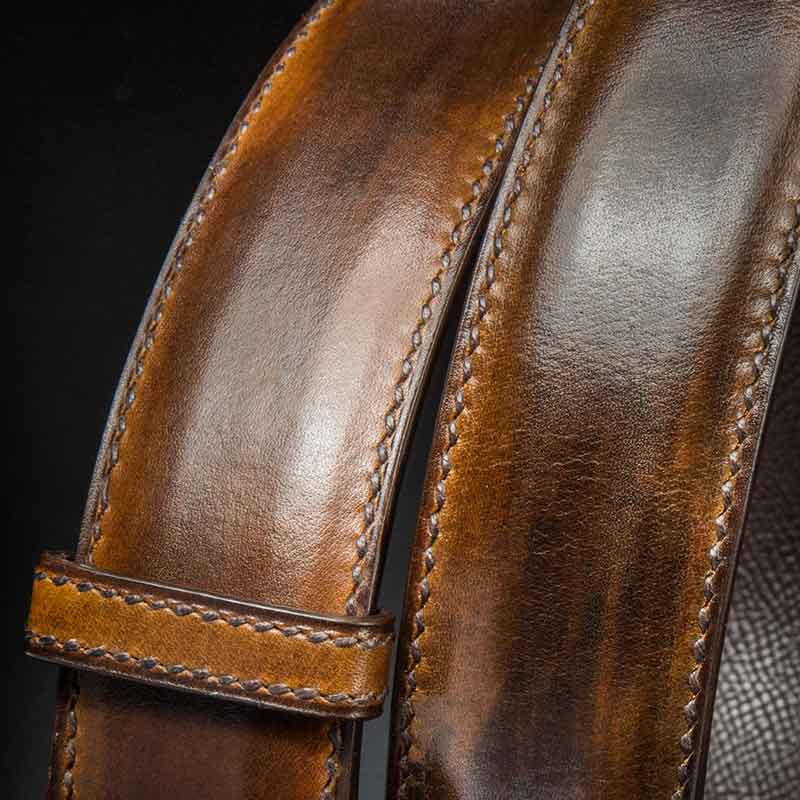The Importance of Skilled Labour in Leathercraft

Delving into the world of leathercraft is to uncover a realm where the artisan’s hand plays a pivotal role in the quality and uniqueness of each creation. Behind every luxury bag, belt, or wallet lies meticulously acquired expertise, handed down through generations. Far from being confined to mere technical gestures, artisanal mastery transforms raw materials into true works of art. This rich and intricate heritage is vital for ensuring flawless finishes and creations that are both elegant and enduring. Yet, skilled labour faces significant challenges, from the transfer of expertise to the pressures of industrialisation. Recognising the importance of this craftsmanship is to grasp the very essence of luxury leatherwork, where each gesture, each stitch, bears the hallmark of excellence and a passion for well-crafted work.
The Heritage of Artisanal Craftsmanship in Leatherwork.
For centuries, leathercraft has relied on artisanal expertise passed down through generations, embodying a tradition deeply rooted in the culture of luxury. This heritage is reflected in every precise gesture of the craftsmen, who blend tradition and technique to elevate leather to its highest form. Each handcrafted piece carries within it the legacy of age-old techniques, such as cutting, dyeing, and hand stitching. These skills, often jealously guarded, enable the creation of products of unparalleled quality, where the precision of the artisan’s touch ensures flawless finishes. This heritage, which leathercraft artisans continue to uphold, forms the very soul of this art. The richness of this legacy is not merely a matter of technique but also of passion and dedication, infusing each creation with a unique authenticity and emotional value, far removed from industrial standards.

Essential Skills for Quality Products.
To ensure high-quality leather goods, mastery of specific technical skills is essential. The process begins with the careful selection of leathers, where the artisan identifies the most suitable hides based on their suppleness, texture, and durability. Next comes the cutting, an art in itself that demands millimetre precision to optimise each piece and minimise material waste. Hand-stitching, a symbol of excellence, requires great dexterity to achieve even, strong stitches, ensuring the solidity and longevity of each creation. The finishing touches, such as edge polishing or the application of dye to the edges, add the final flourish that distinguishes a premium product. Each of these steps, executed with care, reflects the artisan’s expertise and imparts the leather creations with an impeccable quality, recognised worldwide.


The Impact of Skilled Labour on Creating Unique Pieces.
Skilled labour plays a fundamental role in the creation of unique leather goods, offering far more than just a product. Artisans bring their expertise to transform each project into a bespoke creation, tailored to the client’s desires. Their craftsmanship allows for the customisation of every detail, whether it be dimensions, colours, or finishes. These skills breathe life into unique accessories, crafted to meet the most specific expectations while staying true to the identity of the brand. Each piece becomes a reflection of the artisan’s creativity and meticulousness, with careful attention paid to every stage, from design to final assembly. This investment in artisanal quality ensures unparalleled durability and aesthetics, making each creation both functional and timeless, while guaranteeing a truly exclusive customer experience.
A Key to the Sustainability of Luxury and Excellence.
The sustainability of luxury leathercraft relies on the transmission and preservation of its artisanal expertise, a crucial challenge in the face of evolving production methods. While industrialisation offers faster and more cost-effective processes, it cannot compete with the quality and authenticity of handcrafted pieces. To maintain this standard of excellence, it is essential to train new generations of artisans in traditional techniques, such as vegetable tanning and hand stitching, while instilling in them the industry’s high standards of quality. Some brands invest in internal schools to pass on these skills, ensuring the continuation of this centuries-old craft. At the same time, artisanal workshops must adapt to modern expectations, particularly regarding sustainability and the traceability of materials. Preserving this expertise is vital to safeguarding the future of luxury leathercraft, where every creation stands as a testament to exceptional, timeless, and inimitable craftsmanship.

The importance of skilled labour in luxury leathercraft extends beyond mere artisanal production; it touches the very essence of the industry, where quality and authenticity are core values. Beyond preserving traditions, this expertise fosters innovation, allowing ancient techniques to be reimagined to meet the demands of a market seeking personalisation and sustainability. The ability to blend ancestral craftsmanship with contemporary expectations makes leathercraft a pillar of the luxury sector, capable of adapting to change without compromising quality. However, the future of this art rests on a delicate balance between honouring craftsmanship and training a new generation of artisans. If this balance is maintained, luxury leathercraft will continue to embody a certain ideal of excellence, where each creation, the result of meticulous expertise, transcends mere function to become a true work of art. This is the ultimate challenge: to preserve this heritage so that emotion and craftsmanship are passed down through every unique piece.
